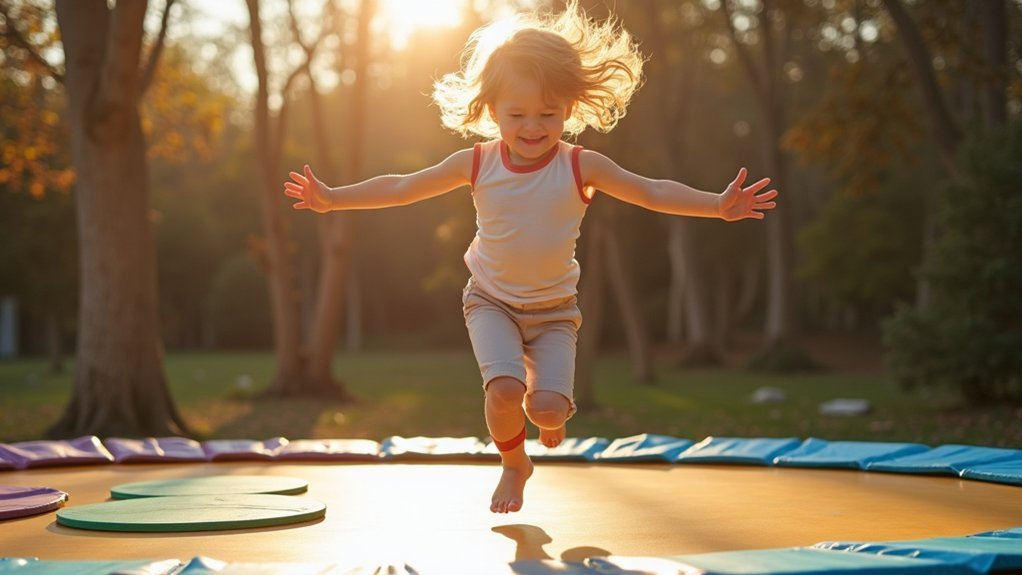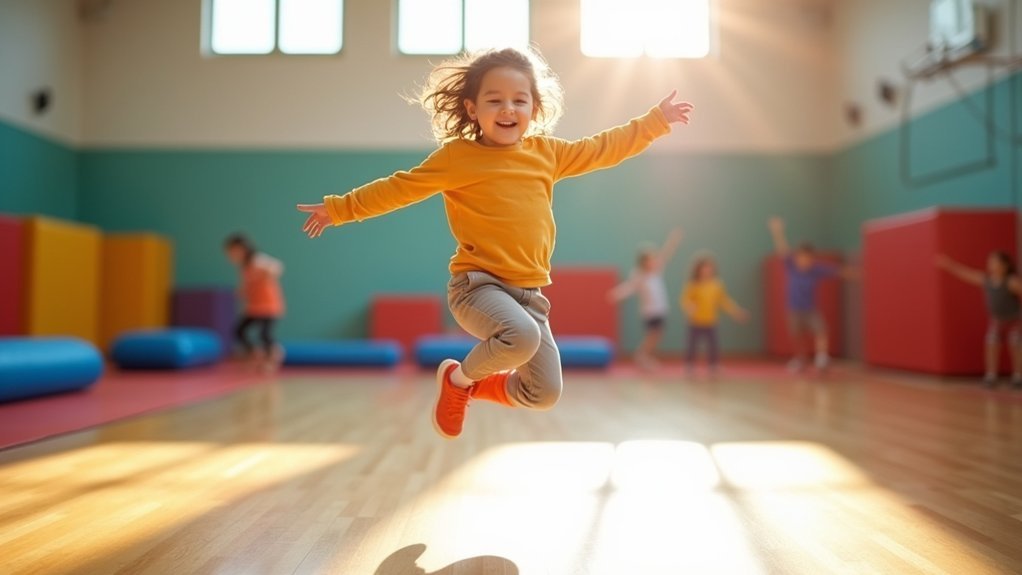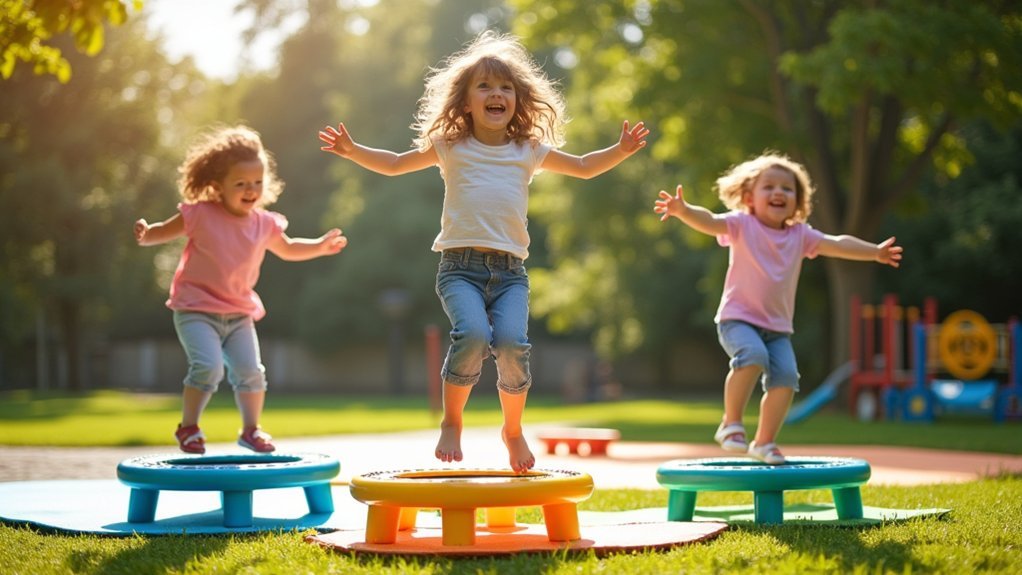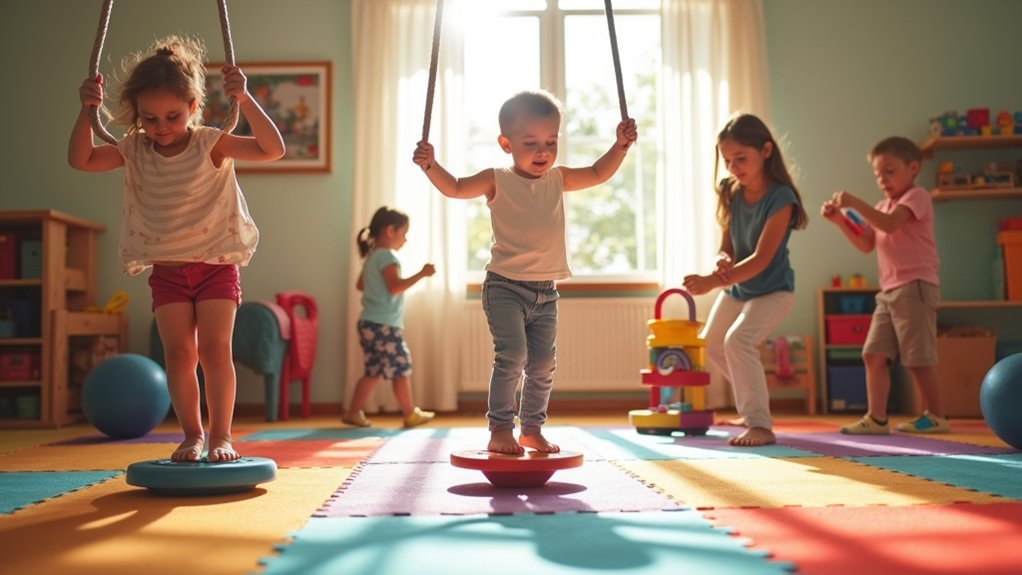The 7 best sensory integration moves for motor development include trampoline core strengthening, rhythmic rebounding, cross-pattern jumping, proprioceptive challenge games, tactile sensory targets, visual tracking exercises, and multi-sensory rebounding circuits. These activities enhance your child’s balance, coordination, brain integration, and body awareness while making physical development fun. Each technique targets specific neural pathways and sensory systems, creating a thorough approach to motor skill development. Discover how these playful movements can transform your child’s physical capabilities.
Bounce and Balance: Trampoline Core Strengthening

Bouncing on a trampoline activates a child’s entire core muscle system while delivering powerful sensory input. This dynamic activity provides essential proprioceptive input that helps your child develop better body awareness and coordination through repeated movement patterns.
You’ll notice improved gross motor skills as your child’s muscles adapt to the constant engagement required during jumping. The trampoline’s unstable surface challenges balance reflexes, strengthening abdominal and back muscles that support proper posture and stability.
For children at different developmental stages, you can easily modify trampoline exercises to match their abilities. The sensory stimulation from bouncing enhances vestibular processing, which contributes to better spatial orientation.
Core strengthening through trampoline play creates a foundation for confident movement in all physical activities.
Rhythmic Rebounding for Vestibular System Stimulation
Three key neural pathways activate when your child engages in rhythmic rebounding activities. This movement stimulates their vestibular system, creating a foundation for improved balance and spatial awareness.
When children rebound rhythmically, their brain activates key neural pathways that transform balance and spatial awareness.
When your child jumps, their brain processes sensory input that’s essential for developing refined motor skills.
Rhythmic rebounding offers powerful sensory integration benefits:
- Provides consistent proprioceptive feedback that builds muscle tone and body awareness
- Creates multi-directional movement patterns that enhance coordination and motor planning
- Offers a calming effect for overstimulated children while engaging sensory-seeking behaviors
You’ll notice improvements in your child’s confidence as their body control develops through regular rebounding practice.
This enjoyable activity doesn’t just feel like play—it’s systematically strengthening neural connections essential for physical development.
Cross-Pattern Jumping Sequences for Brain Integration

Cross-pattern jumping exercises strengthen the communication between your brain’s hemispheres, boosting coordination and cognitive function through movements that connect opposite sides of the body.
You’ll notice improvements in your child’s motor planning as they progress from simple bilateral movements to more complex cross-midline patterns.
Try playful games like “Cross-Jump Tag” or “Hopscotch Hands” where your child jumps to connect opposite hand-to-foot positions, making brain integration both fun and effective.
Brain Hemisphere Communication Benefits
When the brain’s left and right hemispheres communicate effectively, cognitive development flourishes in remarkable ways.
Cross-pattern movements directly stimulate your child’s corpus callosum, strengthening the neural pathways essential for information processing and bilateral coordination.
You’ll notice improved motor skills and sensory processing as your child engages in these integrative activities:
- Diagonal jumping exercises enhance their ability to coordinate both sides of the body while processing multiple sensory inputs simultaneously.
- Alternating foot patterns strengthen neural connections, supporting better academic performance and problem-solving abilities.
- Cross-lateral movements like skipping and hopping improve balance, spatial awareness, and motor planning.
Bilateral Movement Progression
Bilateral movement progression builds upon the foundation created through hemisphere communication activities.
Cross-pattern jumping sequences specifically target the integration between your child’s left and right brain hemispheres, enhancing their gross motor planning and execution.
When your child performs these jumping patterns—reaching across their body or alternating sides—they’re developing essential proprioceptive awareness. This sensory input helps them understand where their body is positioned in space, improving coordination considerably.
These movements simultaneously stimulate their vestibular system, supporting balance and spatial orientation necessary for advanced motor skills.
Try incorporating rhythmic elements into these sequences to boost auditory processing alongside physical development.
Regular practice of these bilateral movement activities creates a strong foundation for complex physical skills your child will need for sports and everyday activities, while strengthening the neural pathways between brain hemispheres.
Cross-Midline Jumping Games
Jumping across the body’s invisible midline creates powerful neural connections in your child’s developing brain. These playful movements enhance coordination while providing essential proprioceptive input that supports sensory integration challenges.
When your child performs cross-pattern jumping sequences, they’re simultaneously engaging both brain hemispheres, greatly improving their motor skills and balance.
Try these fun cross-midline activities:
- “X-Jump”: Have your child jump while touching right hand to left foot, then switch sides
- “Star Hops”: Jump with arms and legs spread, then cross arms and legs while jumping inward
- “Cross-Clap Jumps”: Jump while clapping hands under alternating legs
These games transform neural development into play, making them ideal for children who need extra support with motor planning and cross-body coordination.
Proprioceptive Challenge Games on Mini Trampolines

Mini trampolines offer your child powerful proprioceptive input through bouncing activities that strengthen their core muscles while improving balance.
You’ll notice enhanced coordination as your child jumps and lands with increasing control, developing spatial awareness and motor planning skills with each session.
These bouncing challenges create the perfect sensory-rich environment for your child to build body awareness while having fun, making it easier to integrate these movements into daily routines.
Bouncing Balance Benefits
When children step onto a mini trampoline, they’re entering a powerful proprioceptive playground that enhances their sensory integration naturally. The rhythmic bouncing delivers constant proprioceptive input to muscles and joints, helping your child develop better body awareness while strengthening gross motor skills.
Mini trampoline activities offer exceptional motor development benefits through regular practice:
- Bouncing requires constant postural adjustments, improving balance and core stability as your child learns to maintain control.
- Sensory integration happens effortlessly as repetitive movement patterns help regulate sensory responses, especially beneficial for children with processing difficulties.
- Complex movements like jumping while catching or throwing develop coordination and promote social skills through interactive play.
You’ll notice improvements in your child’s confidence and physical abilities as these bouncing challenges become part of their sensory-motor routine.
Core Strength Development
Although often overlooked, core strength forms the foundation for nearly all movement patterns in developing children. Mini trampolines offer an exceptional tool for proprioceptive input while specifically targeting these essential muscles. When your child bounces, they’re actively engaging their core to maintain balance and coordination.
| Challenge Game | Benefits | Skill Level |
|---|---|---|
| Target Jump | Improves motor planning and accuracy | Beginner |
| Twist & Bounce | Enhances rotational core strength | Intermediate |
| Catch & Balance | Combines coordination with stability | Advanced |
Try having your child jump while maintaining different body positions. These variations increase the demand on their stabilizing muscles, promoting better gross motor skills. You’ll notice improvements in their ability to control movements and maintain posture during other activities, as their body awareness develops through these engaging proprioceptive challenges.
Coordination Through Jumping
Jumping activities naturally extend the core strength benefits into full-body coordination development.
When your child bounces on a mini trampoline, they receive powerful proprioceptive feedback that builds body awareness while engaging multiple muscle groups essential for gross motor development.
You’ll notice improvements in your child’s motor coordination as they master these trampoline challenges:
- Play “bounce and catch” to enhance hand-eye coordination and timing skills
- Adjust the intensity of jumps to create customized proprioceptive challenges matching your child’s abilities
- Incorporate rhythm games where they jump to music, developing motor planning and sequencing
Regular jumping sessions create measurable gains in balance and agility—key components for athletic skills.
The controlled environment of a mini trampoline offers a safe space for children to develop these fundamental movement patterns.
Tactile Sensory Targets for Precision Jumping
The precise coordination of landing on tactile targets represents a significant milestone in children’s motor development. When you introduce textured surfaces like foam pads under jumping targets, you’re providing varied sensory input that helps children refine their techniques. These tactile targets enhance their ability to judge distances and land accurately, building essential gross motor skills.
| Target Type | Development Benefit |
|---|---|
| Textured mats | Enhances proprioceptive feedback |
| Colorful pads | Improves visual-motor integration |
| Varying heights | Builds balance coordination |
| Contrasting surfaces | Increases sensory discrimination |
| Soft landing zones | Develops confident jumping skills |
You’ll notice improved body awareness as children practice jumping from different heights onto specific targets. This regular practice helps them adjust movements based on tactile feedback, ultimately strengthening overall motor development and coordination.
Visual Tracking Exercises While Rebounding
When children bounce on mini trampolines while tracking moving objects with their eyes, they develop critical neural connections between visual processing and motor skills. This combination stimulates the vestibular system while enhancing spatial awareness, making rebounding an excellent sensory integration activity.
Try these effective visual tracking exercises during rebounding sessions:
- Toss a colorful ball upward while your child bounces, asking them to follow it with their eyes without turning their head.
- Place targets at different heights around the trampoline for your child to focus on during specific bounce sequences.
- Introduce moving objects like scarves or ribbons that create unpredictable patterns for advanced tracking challenges.
These exercises don’t just improve coordination—they enhance attention span and focus, creating a foundation for better academic performance and sports abilities through integrated motor skills development.
Multi-Sensory Rebounding Circuits for Motor Planning
Expanding upon individual tracking exercises, multi-sensory rebounding circuits offer a thorough approach to developing motor planning abilities in children. These structured circuits incorporate trampolines and gym balls to provide essential vestibular input that enhances balance and coordination.
You’ll want to organize these circuits in three phases: begin with alerting activities that stimulate the vestibular system, follow with organizing tasks for motor planning, and conclude with calming exercises to restore focus. Just 15-20 minutes of rebounding can greatly improve sensory integration and learning readiness.
Structure your rebounding circuit with alerting, organizing, and calming phases for optimal sensory integration in just 15-20 minutes daily.
Include varied movements like skipping, hopping, and animal walks to develop gross motor skills and body awareness.
Always monitor each child’s response, adjusting activities to match their sensory preferences and tolerance levels for maximum effectiveness.
Frequently Asked Questions
What Are Activities for Sensory Motor Skills?
Try crawling through tunnels, doing animal walks, stringing beads, peeling stickers, jumping on trampolines, performing jumping jacks, manipulating play dough, and using clothespins. These activities develop your fine and gross motor coordination.
What Is an Example of Sensory Motor Integration?
When you’re jumping on a trampoline, you’re experiencing sensory motor integration in action. Your brain processes vestibular input from movement, proprioceptive feedback from your muscles, and visual information to coordinate your jumps effectively.
What Are the Exercises for Sensory Integration?
You’ll benefit from proprioceptive exercises like pushing heavy objects, vestibular activities such as swinging, oral-motor tasks like chewing gum, and structured sensory circuits with alerting, organizing, and calming phases for effective integration.
What Are Sensory Motor Interventions?
Sensory motor interventions are therapeutic activities you’ll use to improve how your body processes sensory input and responds with coordinated movement. They’re designed to enhance your brain-body connection through structured physical exercises.
In Summary
You’ve now discovered seven powerful trampoline-based sensory exercises that’ll transform your child’s motor skills. By incorporating these bouncing activities regularly, you’ll strengthen their vestibular system, enhance proprioception, and improve cross-brain communication. Don’t underestimate how these playful rebounding movements build core strength and coordination while engaging multiple senses. Start small, stay consistent, and watch as your child’s balance, focus, and motor planning abilities flourish through joyful sensory integration.





Leave a Reply